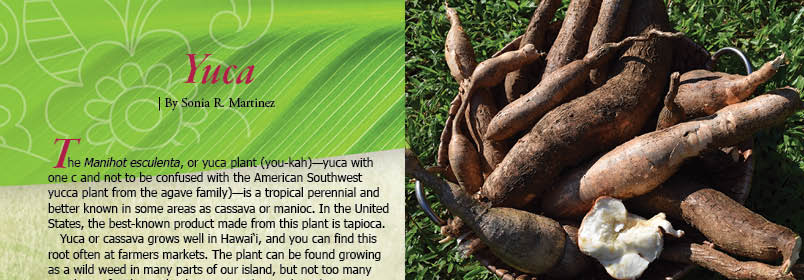
Yuca
The Manihot esculenta, or yuca plant (you-kah)—yuca with one c and not to be confused with the American Southwest yucca plant from the agave family)—is a tropical perennial and better known in some areas as cassava or manioc. In the United States, the best-known product made from this plant is tapioca.

Yuca or cassava grows well in Hawai‘i, and you can find this root often at farmers markets. The plant can be found growing as a wild weed in many parts of our island, but not too many people are familiar with what it is or what to do with it.
It can grow up to 15-feet high with leaves shaped sort of like small, smooth papaya or schefflera leaves. The edible parts are the leaves and the starchy tuberous root, which can grow up to 2-feet long and has a hard, creamy white center covered with a pink skin and then a rough brown bark. It is difficult to peel, and care should be taken when using a sharp knife.
There are several varieties growing around the world, however two varieties are best known: the bitter and the sweet. The bitter contains higher concentrations of cyanogenetic glucosides (poisonous plant compounds that can cause headaches in some humans) than the sweet types. Cooking usually takes care of this problem. The varieties seen growing in Hawai‘i are the sweet type and are easiest to prepare by simply boiling or roasting.
When making soups or stews, peeled, chunked, or diced yuca can be substituted for potatoes, taro, or ‘ulu (breadfruit), or can be added along with all the other vegetables that you normally use.
Yuca con Mojo
Mojo (moe-hoe) is the sauce used by many Caribbean countries to season vegetables and pork. In Cuba, my native country, this is the simplest and most popular way to prepare yuca.
1-1/2 pounds yuca roots, peeled and cut in chunks
1 tsp salt
Juice of one large lime
1 large pot of water
First cut a small shallow X on both ends of each yuca chunk. This seems to help the tuber expand (we call it ‘blooming’) when boiling. Place the yuca chunks in a large saucepan or pot with water just covering. Add the salt and lime juice and bring to a boil. Reduce heat, cover, and continue cooking at low heat until tender, about half an hour. Drain. Remove the wick-like cord or vein running through the center of each piece.
While the yuca is cooking, start preparing the Mojo Sauce.
Mojo Sauce
The authentic mojo is made with juice from sour oranges. It still has that faint orangey taste, and it’s highly acidic and tart. If no sour oranges are available, you can use Rangpur lime or a combination of equal portions orange and lime juices.
6–8 cloves garlic, thinly sliced or minced
1 tsp salt
2/3 C sour orange juice or lime juice
1/2 tsp ground cumin
1/3 C olive oil
Mash garlic cloves and salt with a mortar and pestle; add the sour orange juice blending well.
Heat the mixture in a saucepan until fragrant and the garlic is light beige; do not let garlic turn brown or the taste will be bitter. Add cumin and olive oil. Bring to a quick boil and then simmer until ready to serve.
Place yuca on a platter or bowl and drizzle with the Mojo Sauce. Serve.
Mojo is best when served within a couple of hours of making, although it will keep for several days, well capped in a jar or bottle in the refrigerator.
Yuca Fingers
You can use leftover boiled yuca con mojo by cutting the chunks lengthwise into strips, then frying in olive oil. Serve with more mojo sauce.
Yuca Fritters
These can be made fresh or with leftover boiled yuca (before you add the mojo sauce), as long as the yuca is hot. It is too hard to mash the yuca into paste once it gets cold.
1 pound boiled hot yuca
2 eggs, separated
2 T freshly squeezed lime juice or vinegar
1 tsp salt
1 1/2 C vegetable oil
Boil the peeled and cut yuca until very tender. Carefully discard the wick-like cord or vein. Quickly place the hot yuca in the bowl of a food processor and pulse until it becomes a paste; do not over process or it will turn into glue.
Add the egg yolks, lime juice, and salt. Pulse again until well mixed. Beat the egg whites until stiff but not dry and fold into the yuca batter. Drop in the hot oil by the tablespoon and fry until golden. Drain on paper towels. The lime juice or vinegar will prevent the fritter from absorbing too much oil.
Serve with honey or fruit syrup as dessert, or if you prefer them as a savory dish and as part of your meal, add two small cloves of minced garlic to the batter while adding the egg yolks. You can also make them piquant by adding a small chopped Hawaiian chile pepper to your batter.
Contact writer Sonia R. Martinez



